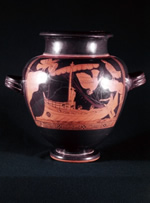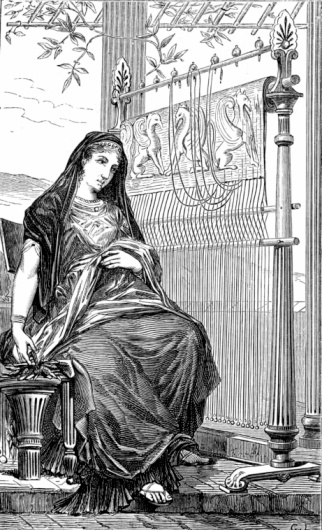 |
TROY Activities for Homer's Odyssey |
1. Read The Trojan War, Chapter 4: "Homer's Odyssey: The Long Journey Home."
2. Explore the links on the Homer & the Troy Cycle page.
3. Read through all the Activity questions before selecting Activities to work with. Some of the Activities are quite easy and may only require reading part of the Odyssey, while others are far more difficult, and may require reading more than one text or doing online research plus reading texts.
Select Activities that interest you and are appropriate to the time you have to spend on them. You will not get a higher grade because you select a more difficult Activity. Some Activities that are especially complex will offer double credit; if so, that will be stated in the Activity question. If you select the double credit option, you must write "double credit" on your Activity AND you must develop your Activity in substantially more depth, in order to qualify for the double credit.
Follow the directions in your Blackboard course site to submit your activities.
The sirens are singing to Odysseus and his crew has stopped their ears so they can avoid temptation.
While Penelope is waiting at her loom
 1. Athena is Odysseus' patron deity; he is her favorite human being. Look at
at least several different scenes in the Odyssey where they interact and describe their relationship in some detail, giving specific examples from more than one book of the Odyssey. 1. Athena is Odysseus' patron deity; he is her favorite human being. Look at
at least several different scenes in the Odyssey where they interact and describe their relationship in some detail, giving specific examples from more than one book of the Odyssey. |
 2. List
at least six of the women, mortal and divine in the Odyssey and write a brief description of each one. Then explain in specific detail what role each one plays in the Odyssey. Finally, write a paragraph or two summing up Homer's ideas about the roles of women in the Odyssey--what they are like and how they are treated.
You must support your ideas by referring to the specific roles of
specific women in specific passages of the Odyssey. 2. List
at least six of the women, mortal and divine in the Odyssey and write a brief description of each one. Then explain in specific detail what role each one plays in the Odyssey. Finally, write a paragraph or two summing up Homer's ideas about the roles of women in the Odyssey--what they are like and how they are treated.
You must support your ideas by referring to the specific roles of
specific women in specific passages of the Odyssey. |
 3. Why does Odysseus go to Hades and what does he learn there? Go into plenty of detail, using specific examples from Book 11 of the Odyssey to support your ideas. 3. Why does Odysseus go to Hades and what does he learn there? Go into plenty of detail, using specific examples from Book 11 of the Odyssey to support your ideas. |
4.  Compare Odysseus to a modern hero. The modern hero may be a fighter, a ruler, a leader, or an athlete; he may be real or fictional.
But please, select a significant publically recognized hero, not just
a friend or family member, no matter how much you admire that person. Write a brief biography of each hero, looking at the specifics of his family life, beliefs, friendships, activities, heroic behavior, etc. Then, explain how each hero affects the society he lives in and how people feel about him. Finally, what are the most interesting differences between
these two heroes and so what? Compare Odysseus to a modern hero. The modern hero may be a fighter, a ruler, a leader, or an athlete; he may be real or fictional.
But please, select a significant publically recognized hero, not just
a friend or family member, no matter how much you admire that person. Write a brief biography of each hero, looking at the specifics of his family life, beliefs, friendships, activities, heroic behavior, etc. Then, explain how each hero affects the society he lives in and how people feel about him. Finally, what are the most interesting differences between
these two heroes and so what? |
 5. Go to the Bronze Age
page and scroll down to the section on Images of Bronze Age Troy and Mycenae. Look through the various images and select three that might actually have existed in the world of the Odyssey. Describe each image and explain exactly where in the Odyssey you would expect to find it, who would use it, own it, live in it, etc., and what you could learn about the Odyssey from seeing the image. Support your ideas with specific examples from the Odyssey and from the images. 5. Go to the Bronze Age
page and scroll down to the section on Images of Bronze Age Troy and Mycenae. Look through the various images and select three that might actually have existed in the world of the Odyssey. Describe each image and explain exactly where in the Odyssey you would expect to find it, who would use it, own it, live in it, etc., and what you could learn about the Odyssey from seeing the image. Support your ideas with specific examples from the Odyssey and from the images. |
 6. Go to the Homer & the Troy Cycle page and look at several images of either artifacts or paintings relating to the Troy Cycle. Select three images which deal with the events of the Odyssey. Describe each image and compare it to the corresponding scene in the Odyssey. How has the artist interpreted the characters, events, etc.? Do you agree with the artist's interpretation? Why or why not? Explain using specific examples to support your points. 6. Go to the Homer & the Troy Cycle page and look at several images of either artifacts or paintings relating to the Troy Cycle. Select three images which deal with the events of the Odyssey. Describe each image and compare it to the corresponding scene in the Odyssey. How has the artist interpreted the characters, events, etc.? Do you agree with the artist's interpretation? Why or why not? Explain using specific examples to support your points. |
 7. Go to the Homer & the Troy Cycle page and scroll down to the section on the Troy Cycle. Look at the list of Troy epics and the characters and plot of the overall Troy Cycle to get a feeling for the mythic context of the Odyssey. Now think about the relations of gods and humans in the Odyssey. Select two interesting scenes where gods and humans interact. Describe each scene in some detail and explain its role in the overall story. Do you think these gods were any more or less real to Homer than the heroes? Why or why not? Support your ideas with specific examples from the Odyssey. 7. Go to the Homer & the Troy Cycle page and scroll down to the section on the Troy Cycle. Look at the list of Troy epics and the characters and plot of the overall Troy Cycle to get a feeling for the mythic context of the Odyssey. Now think about the relations of gods and humans in the Odyssey. Select two interesting scenes where gods and humans interact. Describe each scene in some detail and explain its role in the overall story. Do you think these gods were any more or less real to Homer than the heroes? Why or why not? Support your ideas with specific examples from the Odyssey. |
 8. Go to Bulfinch's Mythology and look up the stories of two or three major gods and/or heroes from the Odyssey. Now select one or more specific scenes in the Odyssey that can be better understood after reading about the characters' mythological roles. Explain the way the mythology helps you to understand each scene, using specific details from both Bullfinch and the Odyssey to support your ideas. 8. Go to Bulfinch's Mythology and look up the stories of two or three major gods and/or heroes from the Odyssey. Now select one or more specific scenes in the Odyssey that can be better understood after reading about the characters' mythological roles. Explain the way the mythology helps you to understand each scene, using specific details from both Bullfinch and the Odyssey to support your ideas. |
 9. Some scholars think that the same person, "Homer," composed both the Iliad and the Odyssey. Others think they were composed by two different people, perhaps some years apart. Indeed, a few people, including Samuel Butler and Robert Graves, have even suggested that a woman wrote the Odyssey. If you have an opinion here, defend it with plenty of good
specific supporting evidence from both epics. (Potential for Double credit: worth up to 100 points.) 9. Some scholars think that the same person, "Homer," composed both the Iliad and the Odyssey. Others think they were composed by two different people, perhaps some years apart. Indeed, a few people, including Samuel Butler and Robert Graves, have even suggested that a woman wrote the Odyssey. If you have an opinion here, defend it with plenty of good
specific supporting evidence from both epics. (Potential for Double credit: worth up to 100 points.) |
 10. Later civilizations disapproved of Homer because "he told lies about the gods." Look in the Odyssey for some of these "lies." List and describe several of them. Do you think Homer actually believed in gods such as he sang about? If so, do you think he was being impious to his gods? Why or why not? Support your position with specific examples from the Odyssey. 10. Later civilizations disapproved of Homer because "he told lies about the gods." Look in the Odyssey for some of these "lies." List and describe several of them. Do you think Homer actually believed in gods such as he sang about? If so, do you think he was being impious to his gods? Why or why not? Support your position with specific examples from the Odyssey. |
 11. Review the scenes in Hades in Books 11 and 24 of the Odyssey. What can you learn about Homer's conception of life after death from reading them? Use specific examples to support your insights. 11. Review the scenes in Hades in Books 11 and 24 of the Odyssey. What can you learn about Homer's conception of life after death from reading them? Use specific examples to support your insights. |
Last Updated: 8/1/2017
(c) Thompson: 9/22/1998

